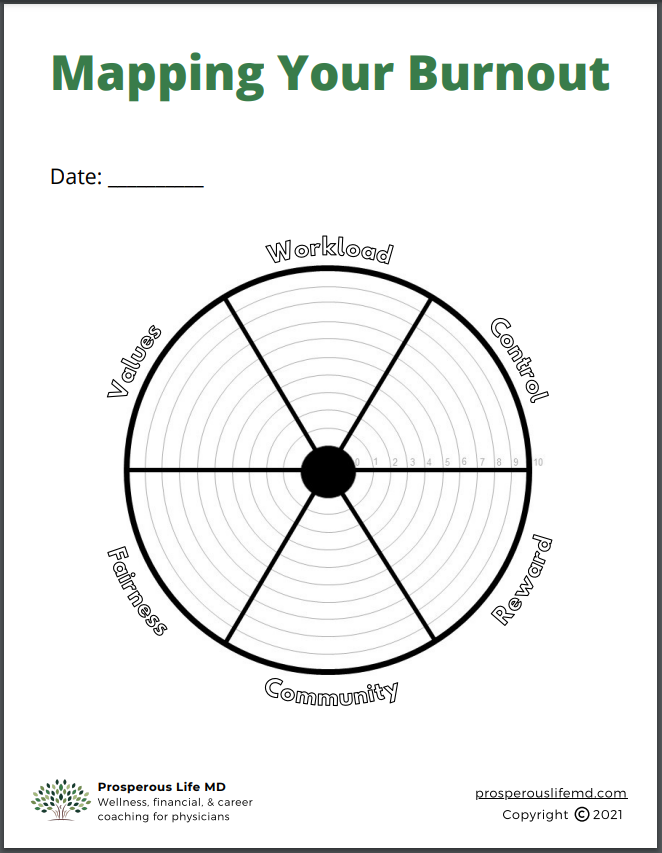Last week I wrote a long piece on the six root causes of burnout as described by Dr. Christina Maslach and colleagues. As I explored each cause, I provided physician-specific context and examples.
This week I introduce a life coaching tool called the wheel of life and incorporate the six underlying causes of burnout.
Within this post is a free downloadable PDF of the wheel of life as it pertains to burnout.

The Wheel of Life for Mapping Out Burnout
Click here or the image above to download and save this wheel of life. Then you can print off copies as needed.
It's the Cirrrrcle, the Circle of Life
Meets the Wheel of Fortune, except not. One was a song (on the first CD I ever purchased!) and the other is a game show that is still somehow on air.
The wheel of life is a visual tool that allows folks to compare how they’re faring in various domains at a single point in time. It’s a snapshot or a check-in from a birds-eye perspective.
It is attributed to Paul Meyer, a life coach from the 1960s, who built the Success Motivation Institute (I didn’t do any further digging 🤷♂️).
The Six Segments
The segments of this wheel template are the six work life areas (Dr. Maslach and Co.’s terminology) described in last week’s post.
As a reminder, they are:
- Workload
- Control
- Reward
- Community
- Fairness
- Values
Most wheels of life are designed to have clients rank their level of satisfaction in each area, but this wheel of life is different.
Here, I’m having you rank how much (on a scale from 0-10) each work life area contributes to your burnout—to map out your burnout.
If you’re not burned out, then you can use it to rank how much each work life area causes you dissatisfaction, if applicable.
Either way, I hope it helps you identify areas of work that can be improved.
Note that each of these work life areas comprises a spectrum, and strength in some of these can offset deficiencies in others.
Step 1: Fill in the Date
Again, this is just a snapshot and you can use it to track how you’re doing. Since it’s a quick pulse check, throw a date on there so you have a timestamp.
Step 2: Grab Your Colors
This is the real test: are you a crayon, colored pencil, or (gasp) marker person?
You will need six different colors for the six different work life areas.
If I may suggest, you can use: 1) blue, 2) royal blue, 3) navy blue, 4) sky blue, 5) baby blue, and, of course, 6) periwinkle.
Some of you may be sticks in the mud and not want to use colors. That’s fine too. But know you’re a stick in the mud.
Step 3 Rate Each Area
Now the meaty stuff. If you’re vegetarian, now the beyond meaty stuff.
Go through the six underlying causes of burnout and rank them from 0-10 (0 = no impact, 10 = worst imaginable impact) in terms of how much each area contributes to your burnout.
Below are sample questions to help you map out your burnout. For more depth on each work life area, please see last week’s post. Please note the questions are phrased negatively to make the rating system a little more intuitive.
- How unreasonable is your workload?
- To what degree do you lack control of your time and efforts? Are there contradictory demands on your time? Is there conflict in fulfilling the duties of your role?
- How insufficient are your rewards (financial, recognition, social) for your efforts?
- To what degree do you lack a sense of community at work?
- How unfair do you perceive your employer (or equivalent) to be?
- How misaligned are your employer’s (or equivalent’s) values with yours?
For example, if your workload is reasonable, you’d put a low score here. However, if your workload is completely unreasonable, then you’d put a 9 or 10.
I’d tell you not to be that person that responds with 11, but you do you.
You betcha:
Put the first number that comes to your mind, not the number you think it should be.
That being said, if you think there’s a very specific or unique reason for your rating on a particular date, then jot that in the margins as a note to yourself.
Step 4: Map Out Your Ratings
The fun part!
Take your ratings and using your preferred writing utensil map them out to the corresponding concentric circles.
For a given work life area’s wedge, shade in the entire area medial to the appropriate circle/arc, as illustrated below:

In the above example, Control is the work life area with the highest burnout score of eight. Conversely, Community is the one with the lowest score of two.
Step 5: Assess & Plan
Look at the wheel you filled in. Chances are it’s pretty lumpy.
It’s hard to move forward on such uneven wheels.
Is this how your work day feels?
You hopefully now have a better idea of which work life areas impact you the most negatively.
Use this information to see what changes you can make at an individual, team, or group level. There may be some quick wins here.
For more pervasive issues, you now know where to target advocacy efforts to best serve you.
Heck, even at contract negotiation time, ii would behoove you to see where there may be some compromise to alleviate dysfunction in your worst off work life areas.
Step 6: Repeat
At a minimum, fill one of these out annually. I’d recommend completing one quarterly to give yourself a better sense of how you feel and if areas are worsening or improving.
I’d also recommend filling one out anytime you feel like you need to take the pulse of where you currently are in terms of burnout and what may be driving it.
Wrapping Up
We turned burnout into an art project! But really, I think there is benefit to writing and drawing these things out due to tactile feedback and making something “real.”
I hope you find this exercise worthwhile and perhaps even illuminating.
It may show you that you’ve been mistargeting your efforts to make changes at work as they won’t move the needle much in your situation; you may get more bang for your burnout buck endeavoring elsewhere.
And in case you were wondering—I’m a colored pencil guy, myself.
Fill one of these out and share your results below. Discover anything surprising? Let me know in the comments below!
If you haven’t subscribed to my email list, then do so below so you don’t miss my new posts or my weekly updates (only for subscribers).
I’d also be most appreciative if you shared this post with anyone whom you think would benefit from the content or message of the blog. They may similarly be most appreciative 

